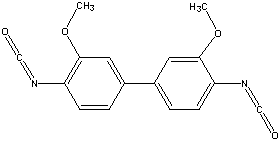
NTP Study Reports

NTP Study Reports
Home » Study Results & Research Projects » NTP Study Reports » All Long-Term Reports » Abstract for TR-128 - 3,3-Dimethoxybenzidine-4,4-Diisocyanate

| Chemical Formula: C16H12N2O4 | - | 3D Structure* | |
|---|---|---|---|
| *To view structure, download free Chemscape Chime Plug-in | |||
3,3'-Dimethoxybenzidine-4,4'-diisocyanate, a dimer of o-anisidine-4,4'-diisocyanate, was selected for bioassay by the National Cancer Institute because of the structural similarity of this compound to 3,3'-dimethoxybenzidine, a carcinogen in Fischer rats.
A bioassay for the possible carcinogenicity of 3,3'-dimethoxybenzidine-4,4'-diisocyanate was conducted using Fischer 344 rats and B6C3F1 mice. 3,3'-Dimethoxybenzidine-4,4'-diisocyanate was administered, at either of two concentrations, to groups of 50 male and 50 female animals of each species, with the exception of 49 high dose female rats. The compound was administered in the feed with the exception of the first 22 weeks of the rat bioassay, when it was administered by gavage. Twenty animals of each sex and species were placed on test as controls. During intubation the high and low dosages were 3,000 and 1,500 mg/kg, respectively, while the high and low concentrations administered in the feed to both rats and mice were 44,000 and 22,000 ppm, respectively. The compound was administered for a period of 78 weeks, followed by an observation period of 26 weeks for rats and 25 weeks for mice.
There was a significant positive association between the administration of 3,3'-dimethoxybenzidine- 4,4'-diisocyanate and mortality in male and female rats, but not in male or female mice. Adequate numbers of animals in all groups survived sufficiently long to be at risk from late-developing tumors.
For both sexes of rats, there was a significant positive association between dosage and the incidence of leukemia and malignant lymphoma. There was a significantly higher incidence of neoplasms of the skin, excluding skin of theear, when dosed male rats were compared to controls. There was a significant positive association between the dosages administered and the incidences of endometrial stromal polyps in female rats. None of the statistical tests for any site in male and female mice indicated a significant positive association between compound administration and tumor incidence.
Under the conditions of this bioassay, administration of 3,3'-dimethoxybenzidine-4,4'-diisocyanate was carcinogenic to Fischer 344 rats, causing neoplasms of the skin (excluding skin of the ear) in males, endometrial stromal polyps in females, and leukemia and malignant lymphoma in both sexes. The compound was also associated with the development of a combination of squamous-cell carcinomas and sebaceous adenocarcinomas of the Zymbal's gland and skin of the ear in rats of both sexes. There was no evidence of the carcinogenicity of the compound in B6C3F1 mice.
| Male Rats: | Positive | |
| Female Rats: | Positive | |
| Male Mice: | Negative | |
| Female Mice: | Negative |
Synonyms: 4,4'-diisocyanato-3,3'-dimethoxy-1,1'-biphenyl; dianisidine diisocyanate; isocyanic acid 3,3'-dimethoxy-4,4'-biphenylene ester; 4,4'-diisocyanato-3,3'-dimethoxy-4,4'-biphenyl diisocyanate; 3,3'-dimethoxy-4,4'-biphenylene diisocyanate
Report Date: 1979
Target Organs from 2-year Studies
You may link to the full technical report in pdf format ( Note: A print ready copy of the document is presented in Portable Document Format (pdf) which requires the Acrobat Reader plug-in -- download a free copy of the reader.)
Web page last updated on October 14, 2004
The National Institute of Environmental Health Sciences is one of the National Institutes of Health within the U.S. Department of Health and Human Services. The National Toxicology Program is headquartered on the NIEHS campus in Research Triangle Park, NC.